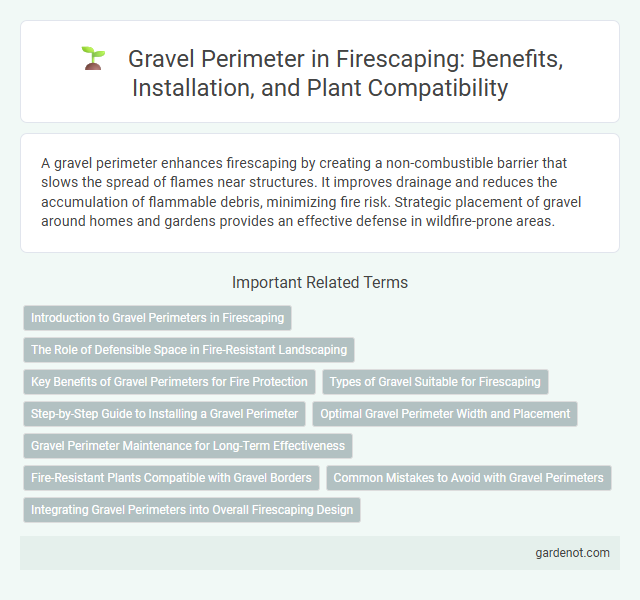A gravel perimeter enhances firescaping by creating a non-combustible barrier that slows the spread of flames near structures. It improves drainage and reduces the accumulation of flammable debris, minimizing fire risk. Strategic placement of gravel around homes and gardens provides an effective defense in wildfire-prone areas.
Introduction to Gravel Perimeters in Firescaping
Gravel perimeters serve as effective firebreaks in firescaping by creating non-combustible barriers that reduce the spread of wildfires near structures. These gravel zones, typically 3 to 5 feet wide, help interrupt fuel continuity and minimize ember ignition risks around homes and landscaping. Utilizing gravel with appropriate depth and composition enhances resistance to fire while promoting drainage and soil stability.
The Role of Defensible Space in Fire-Resistant Landscaping
Gravel perimeter acts as a crucial component in defensible space, reducing combustible material near structures and limiting fire spread during wildfires. Creating a non-flammable gravel barrier around homes enhances fire-resistant landscaping by interrupting fuel continuity and allowing firefighters safer access for protection and suppression. This strategic use of gravel supports fire prevention efforts and increases the overall resilience of properties in high-risk fire areas.
Key Benefits of Gravel Perimeters for Fire Protection
Gravel perimeters create effective firebreaks by reducing combustible vegetation and limiting the spread of wildfires around structures. This non-flammable barrier improves defensible space, enhancing firefighter access and safety during fire events. Properly installed gravel also aids in soil erosion control, maintaining landscape integrity while providing long-term fire protection benefits.
Types of Gravel Suitable for Firescaping
Gravel types suitable for firescaping include pea gravel, decomposed granite, and river rock, each offering varying levels of heat resistance and aesthetic appeal. Pea gravel provides excellent drainage and reduces fire fuel, while decomposed granite compacts well to create a stable, fire-resistant barrier. River rock's smooth, rounded texture helps deflect radiant heat, making it a popular choice for fire-safe landscaping.
Step-by-Step Guide to Installing a Gravel Perimeter
Preparing the area by clearing vegetation and debris ensures a clean base for the gravel perimeter. Lay landscape fabric to prevent weed growth, then spread a 3-4 inch layer of angular gravel evenly around the perimeter of the structure. Compact the gravel firmly to create a stable, fire-resistant barrier that reduces fuel near buildings and enhances wildfire protection.
Optimal Gravel Perimeter Width and Placement
An optimal gravel perimeter width ranges from 2 to 4 feet to effectively reduce wildfire risks by creating a non-combustible buffer zone around structures. Proper placement involves extending the gravel barrier adjacent to the foundation and surrounding vulnerable areas such as decks, eaves, and vents to inhibit ember ignition and direct flame contact. Consistent maintenance ensures gravel remains free of debris and vegetation, maximizing fire resistance and promoting landscape safety.
Gravel Perimeter Maintenance for Long-Term Effectiveness
Regular gravel perimeter maintenance is essential for sustained fire prevention, as it helps to keep the barrier clear of debris, weeds, and organic material that can fuel fires. Periodic raking and replenishing gravel prevent compaction, ensuring optimal fire-resistant properties and proper drainage. Inspections should include checking for erosion or displacement to maintain an effective and continuous firebreak around structures.
Fire-Resistant Plants Compatible with Gravel Borders
Fire-resistant plants such as lavender, rosemary, and succulents thrive along gravel perimeters, creating effective natural barriers that reduce fire risk. These drought-tolerant species require minimal maintenance while enhancing the fire-resistant properties of gravel borders. Combining gravel with fire-adapted vegetation optimizes landscape safety and aesthetic value, forming a resilient buffer zone against wildfires.
Common Mistakes to Avoid with Gravel Perimeters
Common mistakes to avoid with gravel perimeters in firescaping include placing gravel too close to flammable vegetation, which can allow embers to ignite nearby plants. Using gravel that is too fine or contains organic material can trap moisture and increase fire risk. Ensure the gravel layer is deep enough, typically 3 to 4 inches, to create an effective fire-resistant barrier around your property.
Integrating Gravel Perimeters into Overall Firescaping Design
Incorporating gravel perimeters effectively enhances firescaping by creating non-combustible buffer zones around structures, reducing wildfire risk. Selecting appropriate gravel sizes and layering ensures proper drainage while minimizing debris accumulation that could ignite fires. Strategic placement of gravel alongside fire-resistant plants integrates aesthetics with safety, optimizing firebreak functionality within the overall landscape design.
Gravel perimeter Infographic

 gardenot.com
gardenot.com